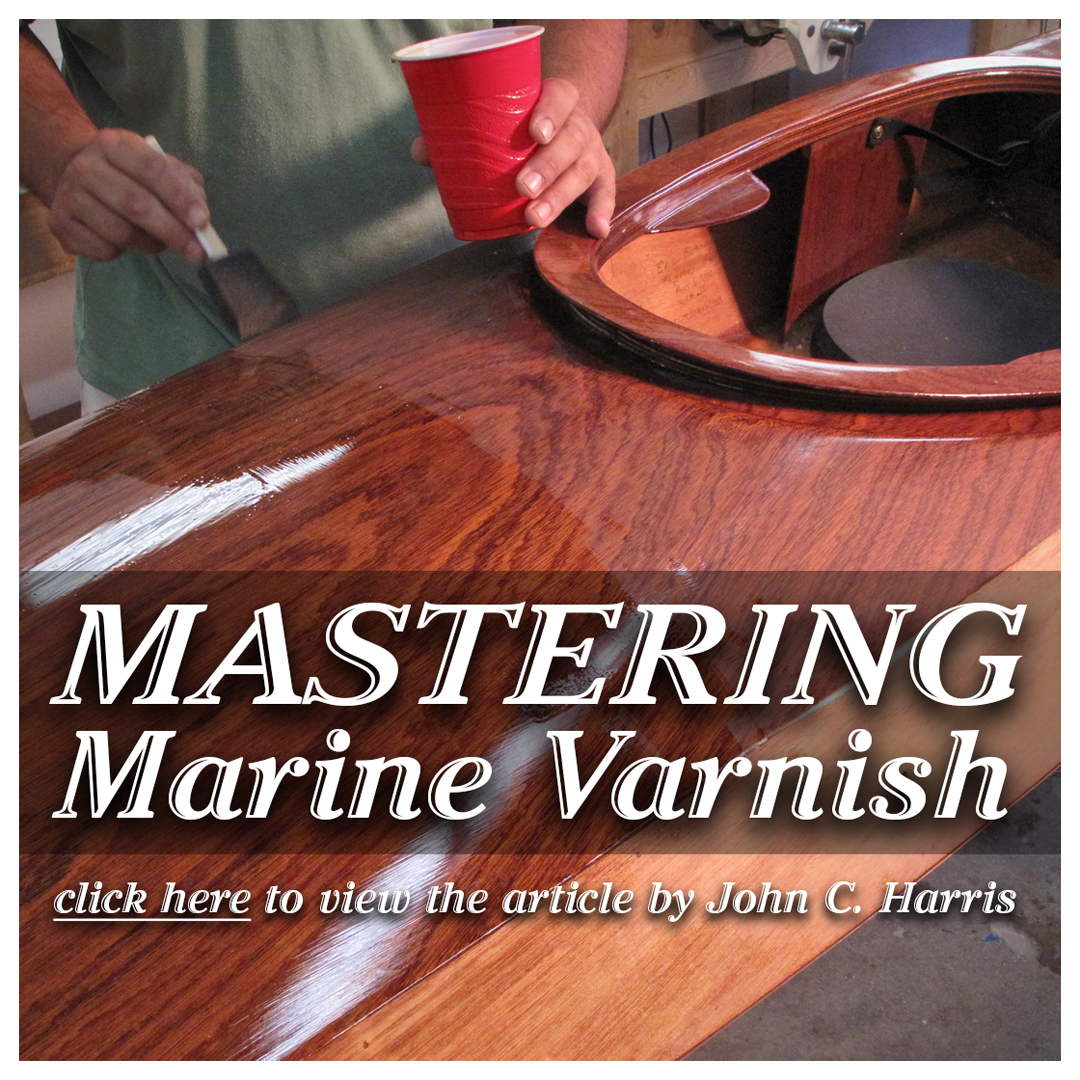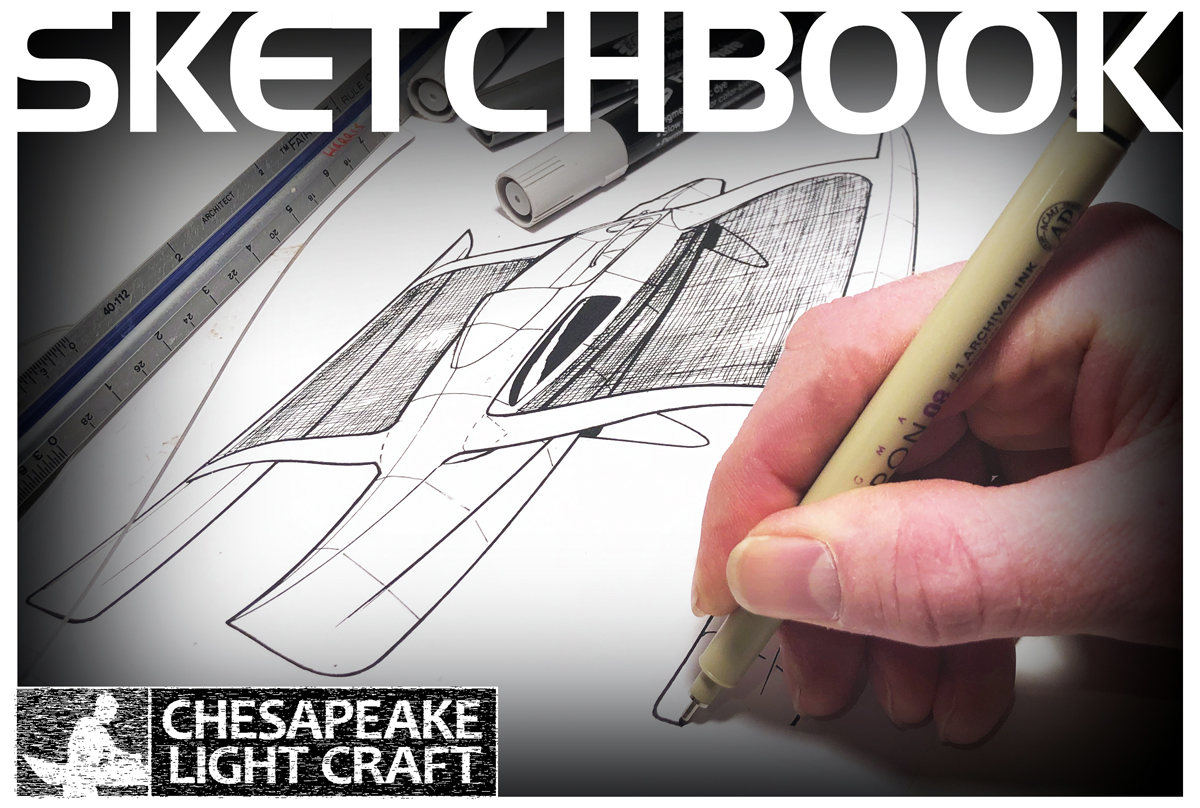"Filling the Weave"

Without epoxy, fiberglass is just an itchy, loosely-woven fabric that you can unravel in your fingers. Saturated and bonded to plywood in a hard matrix of marine epoxy, fiberglass cloth becomes a tough sheathing that is singularly strong and durable. The trick is to gauge how much epoxy to apply to the fiberglass. Too little, and you're missing out on the strength and abrasion resistance of the 'glass sheathing. Too much epoxy, and you're adding a lot of weight but no strength, and you're wasting epoxy.
All of the books say that you should "fill the weave" of the fiberglass cloth with multiple coats of epoxy. But how do you know when it's filled?
 First Coat of Epoxy - The first coat is easy enough to describe: the fiberglass should turn from white to nearly perfectly clear, but the weave of the fabric should still show prominently. Why is this? Well, if the weave disappears under the first coat, the fiberglass might actually float off the surface of the wood. When you come back to sand, you'll sand through the 'glass in a lot of spots and lose a lot of the tensile strength the 'glass fibers are adding to your hull. That's why we advocate using a plastic squeegee or spreader to apply the first coat of epoxy; this way you squeeze out the extra epoxy while simultaneously sticking the fabric firmly to the wood. Don't overdo it, though; dry spots will show up as gray or white patches in the clear coating.
First Coat of Epoxy - The first coat is easy enough to describe: the fiberglass should turn from white to nearly perfectly clear, but the weave of the fabric should still show prominently. Why is this? Well, if the weave disappears under the first coat, the fiberglass might actually float off the surface of the wood. When you come back to sand, you'll sand through the 'glass in a lot of spots and lose a lot of the tensile strength the 'glass fibers are adding to your hull. That's why we advocate using a plastic squeegee or spreader to apply the first coat of epoxy; this way you squeeze out the extra epoxy while simultaneously sticking the fabric firmly to the wood. Don't overdo it, though; dry spots will show up as gray or white patches in the clear coating.
 Second and Subsequent Coats of Epoxy - With the first coat cured, you're not worried about the fiberglass fabric floating off the wood. However, the weave is showing; the hull feels as rough as a wood rasp. Now you start filling up the weave, and this is where it gets a little trickier, because the epoxy behaves differently on the hardened surface. First of all, we recommend using a roller to put on this and subsequent coats of epoxy. It gets the goo deeper into the hardened weave. To make it more interesting, you have almost infinite scope in the thickness of your epoxy application. Too thick, and it runs off the boat onto the floor (and your shoes). Too thin, and nothing seems to change; you don't seem to be filling the weave at all!
Second and Subsequent Coats of Epoxy - With the first coat cured, you're not worried about the fiberglass fabric floating off the wood. However, the weave is showing; the hull feels as rough as a wood rasp. Now you start filling up the weave, and this is where it gets a little trickier, because the epoxy behaves differently on the hardened surface. First of all, we recommend using a roller to put on this and subsequent coats of epoxy. It gets the goo deeper into the hardened weave. To make it more interesting, you have almost infinite scope in the thickness of your epoxy application. Too thick, and it runs off the boat onto the floor (and your shoes). Too thin, and nothing seems to change; you don't seem to be filling the weave at all!
It may take you two thick coats or five thin coats to finish filling the weave of the fabric. The important thing is to know when to stop, and this is where illustrations help.
 Here we have a cross-section of the woven fiberglass fabric, magnified many times, resting on the plywood substrate. The first coat of epoxy is in place; the weave has soaked up all the epoxy and is firmly bonded to the wood.
Here we have a cross-section of the woven fiberglass fabric, magnified many times, resting on the plywood substrate. The first coat of epoxy is in place; the weave has soaked up all the epoxy and is firmly bonded to the wood.
The second coat starts to fill in the gaps in the weave, but the fabric isn't covered in epoxy yet.
With the third and subsequent coats, an interesting thing happens. The fabric has been filled completely, but the weave-pattern actually "prints through" onto the surface of the fiberglass sheathing. (We recommend a light sanding after the second coat to knock off the tops of the "weave pattern.")
You may sand smooth the top coat of epoxy, without sanding into the strong fiberglass weave. You can see this here.
A hard, smooth finish atop the fiberglass. In closing, remember that it isn't fatal if you sand into the fiberglass cloth a little, especially on lightweight sea kayaks. Just be careful on chines and edges, where it's very easy to cut all the way through the fiberglass into the wood.
 Without epoxy, fiberglass is just an itchy, loosely-woven fabric that you can unravel in your fingers. Saturated and bonded to plywood in a hard matrix of marine epoxy, fiberglass cloth becomes a tough sheathing that is singularly strong and durable. The trick is to gauge how much epoxy to apply to the fiberglass. Too little, and you're missing out on the strength and abrasion resistance of the 'glass sheathing. Too much epoxy, and you're adding a lot of weight but no strength, and you're wasting epoxy.
Without epoxy, fiberglass is just an itchy, loosely-woven fabric that you can unravel in your fingers. Saturated and bonded to plywood in a hard matrix of marine epoxy, fiberglass cloth becomes a tough sheathing that is singularly strong and durable. The trick is to gauge how much epoxy to apply to the fiberglass. Too little, and you're missing out on the strength and abrasion resistance of the 'glass sheathing. Too much epoxy, and you're adding a lot of weight but no strength, and you're wasting epoxy.
 First Coat of Epoxy - The first coat is easy enough to describe: the fiberglass should turn from white to nearly perfectly clear, but the weave of the fabric should still show prominently. Why is this? Well, if the weave disappears under the first coat, the fiberglass might actually float off the surface of the wood. When you come back to sand, you'll sand through the 'glass in a lot of spots and lose a lot of the tensile strength the 'glass fibers are adding to your hull. That's why we advocate using a plastic squeegee or spreader to apply the first coat of epoxy; this way you squeeze out the extra epoxy while simultaneously sticking the fabric firmly to the wood. Don't overdo it, though; dry spots will show up as gray or white patches in the clear coating.
First Coat of Epoxy - The first coat is easy enough to describe: the fiberglass should turn from white to nearly perfectly clear, but the weave of the fabric should still show prominently. Why is this? Well, if the weave disappears under the first coat, the fiberglass might actually float off the surface of the wood. When you come back to sand, you'll sand through the 'glass in a lot of spots and lose a lot of the tensile strength the 'glass fibers are adding to your hull. That's why we advocate using a plastic squeegee or spreader to apply the first coat of epoxy; this way you squeeze out the extra epoxy while simultaneously sticking the fabric firmly to the wood. Don't overdo it, though; dry spots will show up as gray or white patches in the clear coating. Second and Subsequent Coats of Epoxy - With the first coat cured, you're not worried about the fiberglass fabric floating off the wood. However, the weave is showing; the hull feels as rough as a wood rasp. Now you start filling up the weave, and this is where it gets a little trickier, because the epoxy behaves differently on the hardened surface. First of all, we recommend using a roller to put on this and subsequent coats of epoxy. It gets the goo deeper into the hardened weave. To make it more interesting, you have almost infinite scope in the thickness of your epoxy application. Too thick, and it runs off the boat onto the floor (and your shoes). Too thin, and nothing seems to change; you don't seem to be filling the weave at all!
Second and Subsequent Coats of Epoxy - With the first coat cured, you're not worried about the fiberglass fabric floating off the wood. However, the weave is showing; the hull feels as rough as a wood rasp. Now you start filling up the weave, and this is where it gets a little trickier, because the epoxy behaves differently on the hardened surface. First of all, we recommend using a roller to put on this and subsequent coats of epoxy. It gets the goo deeper into the hardened weave. To make it more interesting, you have almost infinite scope in the thickness of your epoxy application. Too thick, and it runs off the boat onto the floor (and your shoes). Too thin, and nothing seems to change; you don't seem to be filling the weave at all! Here we have a cross-section of the woven fiberglass fabric, magnified many times, resting on the plywood substrate. The first coat of epoxy is in place; the weave has soaked up all the epoxy and is firmly bonded to the wood.
Here we have a cross-section of the woven fiberglass fabric, magnified many times, resting on the plywood substrate. The first coat of epoxy is in place; the weave has soaked up all the epoxy and is firmly bonded to the wood. 










